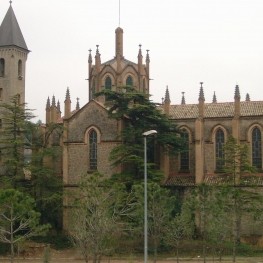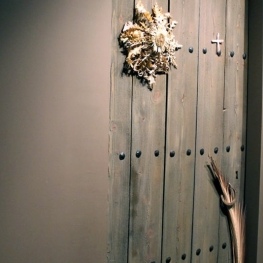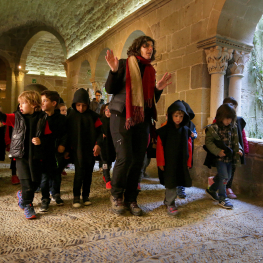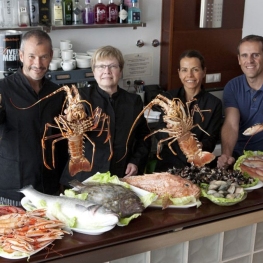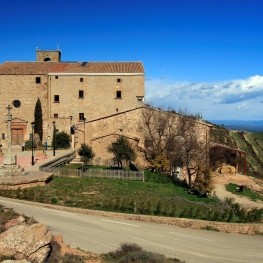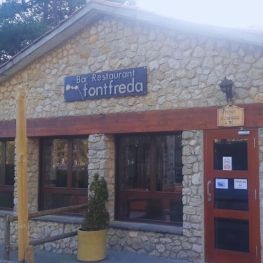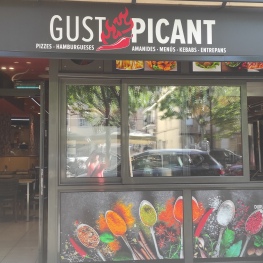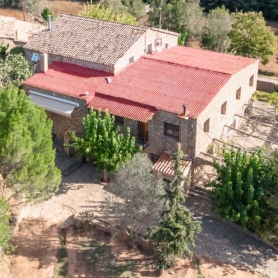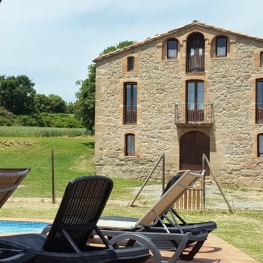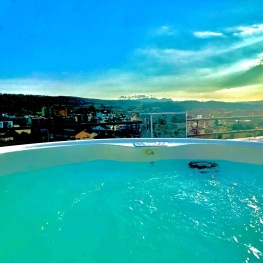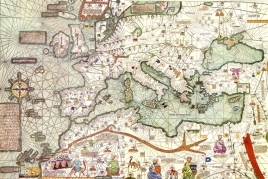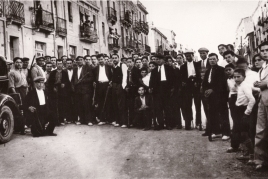Route through the heritage of Balsareny
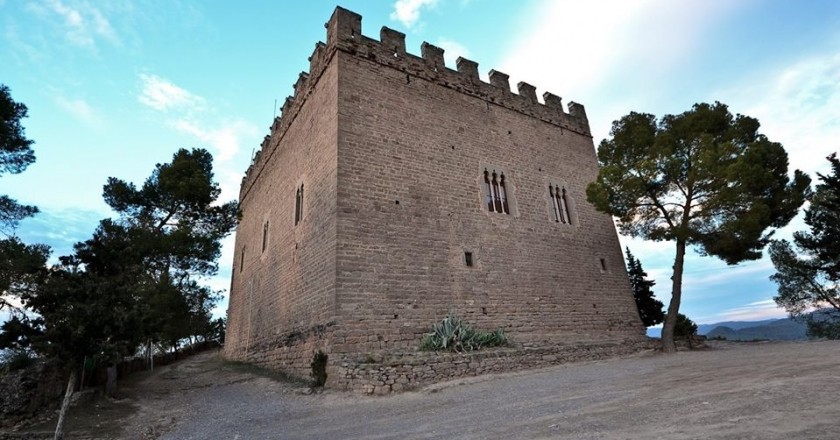
Balsareny is a town located in the Llobregat valley, north of the Bages region . Located in an undulating terrain where white pine forests predominate, the term is very well connected by road as it is crossed by the Eje del Llobregat.
Next, we propose a route to discover the main attractions of the municipality.
Are you with us?
the castle
Balsareny Castle is undoubtedly the most representative and charismatic monument of the population and one of the best known in the region. It is well visible not only due to its location, but also due to its size and good state of preservation. Present since its origins in the events of the town's history, the current appearance of the building corresponds to the purest Catalan civil Gothic style and dates from the 14th century.
It is a Gothic palace castle organized from a central courtyard. Because it has been well planned and built, in accordance with the previous plan and in a single construction campaign, it is one of the few regular and homogeneous castles in central Catalonia.
Its history is linked to the Balsareny lineage. The first character to appear with this name is a county vicar, Guifred de Balsareny. His son Guillermo replaced the famous abbot Oliba as Bishop of Vic, and his granddaughter Guisla married the Count of Barcelona Berenguer Ramón I.
Parish Church of Santa María
 It is mentioned for the first time in 1009. Only a few remains of the old pre-Romanesque building remain on the façade, in the central nave and the bell tower. It is located within the old term of the castle, in the place where later the current population emerged. Very soon it must have been a parish, which it still has today.
It is mentioned for the first time in 1009. Only a few remains of the old pre-Romanesque building remain on the façade, in the central nave and the bell tower. It is located within the old term of the castle, in the place where later the current population emerged. Very soon it must have been a parish, which it still has today.
It is a building that was erected towards the end of the 13th century, but still following the canons imposed by the Romanesque. Important reforms were made in the 16th-17th centuries. Also worth noting is the reclining Christ, the work of the sculptor Josep Cañas.
Fort of the Maurici
Fort located on top of the hill of Mauricio, from which it takes its name. It is located near the town, next to the road that goes to Súria and on the other side of the current Axis of Llobregat. Despite being one of the best examples of military architecture of the last century, it was not completely built.
Despite being built to defend against the Carlists, during the first Carlist war it was occupied by the Count of Spain, who was besieging Balsareny. The count installed his artillery and from there fired at the houses of the town, until the arrival of the liberal troops and the end of the siege.
The fort stands out for the firmness of its factory and the dimensions of its construction.
The Hermitage of the Castle
On the very side of the fortress, (on a landing at noon of it) and in an excellent state of preservation, the chapel stands, a magnificent example of the austerity and purity of the first Catalan Romanesque.
The parish of Santa María is mentioned as early as 1039; the current building preserves the central nave, from the 12th century, topped by a semicircular apse.
More from Puigdorca
More and older place, in the eastern sector of the term, to the left of Llobregat. The church of Santiago, already mentioned in 1154, was suffragan of that of Balsaren and was renovated in the 18th century.
Paintings by Josep Obiols el Casal / Virgen de Montserrat
 Murals in the chapel of the Casa de Balsareny (1945).
Murals in the chapel of the Casa de Balsareny (1945).
Sant Esteve de la Colonia Soldevila
Documented in 1038, the Romanesque church of Sant Esteve, located in the textile colony of the same name, is another monument worthy of admiration. Originally it consisted of a rectangular nave.
A part of the nave and the central apse are evident from the original building. In 1942 it was expanded, adding two neo-Romanesque apses. Restorations have been made to reveal a part of the old building.
Sant Ramon de Sobirania de Ferran
On the Súria road, on a small hill overlooking the Ferran valley, and built during the 12th century, we find another interesting architectural piece, successfully restored.
 The church of Sant Ramon, currently unaffected, is an old parish; of late Romanesque style, it forms a single body with the Soberana farmhouse, from which it takes its name.
The church of Sant Ramon, currently unaffected, is an old parish; of late Romanesque style, it forms a single body with the Soberana farmhouse, from which it takes its name.
One of the most interesting elements of the temple is constituted by the entrance portal open to the midday wall. This portal is formed by three degrading semicircular arches made with voussoirs of regular sizes. The decoration of the southern portal is also interesting for its architectural and sculptural simplicity.
Sant Vicenç de Ladernet
Despite being in a dilapidated state, the structure and a large part of the interior of this pre-Romanesque church can still be seen with complete clarity, located in an ambush, lying on the left bank of the Conangle stream, near the most Candàliga and under the Castellnou tower, on the eastern side of the term.
The place and the church are mentioned in 1035. The complex is made up of two well-differentiated buildings: a pre-Romanesque temple and a tiny Romanesque chapel included within a tower or bell tower with an apse visible on the outside. The pre-Romanesque temple consisted of a rectangular nave with an elongated force.
Given the characteristics of the two buildings, it seems that the pre-Romanesque construction was erected in the 10th century and remodeled in the 11th century, while the Romanesque seems to respond to a work from the late 12th or early 13th century.
Source: Balsareny City Council
What to do
Centre d'interpretació de l'Església de Cal Pons
Puig-reig (a 12.2 Km)The Interpretation Center of the Colonia Pons Church, through three museum spaces,…
Granja Natura (Centre d'Apropament a la Natura)
Navàs (a 3.9 Km)Live a unique experience in close contact with farm, wild, and exotic…
Centre d’Interpretació de la Bruixeria
Sant Feliu Sasserra (a 14.9 Km)The Bruixeria de Sant Feliu Sasserra Interpretation Center invites visitors to get…
Món Sant Benet
Sant Fruitós de Bages (a 13.6 Km)Món Sant Benet is a highly unique cultural, tourist and leisure project.…
Where to eat
Restaurant Marisquer Can Ladis
Sant Fruitós de Bages (a 12.6 Km)The Can Ladis Seafood Restaurant, located in Sant Fruitós de Bages, is…
Hostal de Pinós
Pinós (a 27.9 Km)It is the oldest restaurant in Catalonia that has never closed its…
Restaurant Font Freda
Castellar del Riu (a 28.2 Km)A restaurant offering a wide selection of Catalan dishes, especially notable for…
Restaurant Gust Picant
Berga (a 26.8 Km)At Gust Picant, you can enjoy affordable menus with a wide variety…
Where to sleep
Masia La Figuera
Castellnou de Bages (a 4.7 Km)Leave the routine behind and share good times with your friends at…
Alberg Cal Pons, Fundesplai
Puig-reig (a 11.4 Km)Discover Cal Pons, a hostel that is part of the architectural complex…
Escardívol turisme rural
Viver i Serrateix (a 11.6 Km)Three restored farmhouses for your rural getaway. The common denominator in all…
El Racó d'Artés
Artés (a 9.6 Km)Discover El Rincón de Artés or enjoy an unforgettable experience in the…


